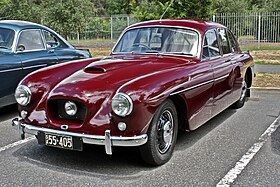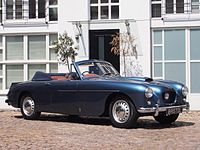Bristol 404 and 405
| Bristol 404 Bristol 405 | |
|---|---|
 Bristol 405 four-door saloon | |
| Overview | |
| Manufacturer | Bristol Aeroplane Co. (now Bristol Cars) |
| Production | 1953–1958 52 Bristol 404 units 308 Bristol 405 units |
| Body and chassis | |
| Class | Luxury car |
| Body style | Two-door coupé (404) Four-door saloon (405) Two-door drophead coupé (405) |
| Layout | FR layout |
| Powertrain | |
| Engine | 1,971 cc ohv I6 2,216 cc ohv I6[1] |
| Chronology | |
| Predecessor | Bristol 403 |
| Successor | Bristol 406 |
The Bristol 404 and Bristol 405 are British luxury cars which were manufactured by the Bristol Aeroplane Company. The 404 was manufactured from 1953 to 1958, and the 405 from 1955 to 1958. The models were successors to the Bristol 403. The 404 was a two-seat coupé and the 405 was available as a four-seat, four-door saloon and as a four-seat, two-door drophead coupé.
Unlike previous or later Bristol models, there is considerable confusion in nomenclature when it comes to the Bristol 404 and 405. The 404 was a very short-wheelbase (8 feet (2,438 mm) as against 9 feet 6 inches (2,896 mm)) version of the 405, but was introduced in 1953, whereas the 405 was not introduced until 1955 and continued until 1958.
The 405 itself was seen in two versions. The more common (265 of 308 built) is a four-door saloon built on the standard chassis of the previous Bristols, whilst the 405 drophead coupé or 405D (43 built) had a coupé body by Abbotts of Farnham and most built had a highly tuned (through advanced valve timing) version of the 2 litre six-cylinder engine called the 100C which developed 125 bhp (93 kW) as against the 105 bhp (78 kW) of the standard 100B 405 engine. All engines for the 404 and 405 had higher compression ratios than previous Bristols — 8.5:1 as against 7.5:1.
Compared to the 403, the 404 and 405 had an improved gearbox with much shorter gear lever which improved what was already by the standards of the day a very slick gearchange. The 405, though not the 404, had overdrive as standard apart from the earliest models, and front disc brakes became an option apart from the earliest models, and were fitted to almost all 405 drophead coupés. A few late 405s were fitted with the torquier 2.2 litre engine introduced in the later 406.[1]
Externally, a notable feature of the 404 and 405 was the abandonment of the BMW-style radiator grille for one much more like an aero-engine. The 405, although the only four-door car ever built by Bristol, had styling that the company was later to refine for many years on their later Chrysler V8-engined cars during the 1960s. It was also the model that introduced the Bristol feature of sizable lockers in the front wings accessed externally by gullwing doors. The locker on the nearside held the spare wheel and jack, whilst that on the offside housed the battery and fuse panel.
-
Bristol 404 two-door coupé
-
Bristol 405 four-door saloon
-
Bristol 405 four-seater drophead coupé
Media references
A maroon 405 is featured prominently in the 2009 independent film An Education, directed by Lone Scherfig, which is a period film set in 1961 in the London suburbs.
A silver 405, described as a hand-built 1958 Bristol, is driven by the character Jack Kerruish (played by Kevin Whately) in the first three series of Peak Practice, set in the early 1990s in the Peak District.
The vicar, Sidney Chamber (played by James Norton), was given a lift in a maroon 405, at the beginning of Grantchester, series 3, episode 5 (2017).
External links
- Bristol Owners Club, Bristol 404 - 2 litre coupé
- Bristol Owners Club, Bristol 405 - 2 litre saloon
- Bristol Owners Club, Bristol 405D - 2 litre drophead coupé
- Buying a six-cylinder Bristol



